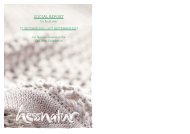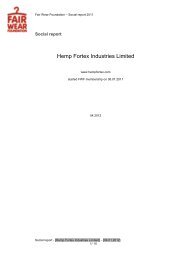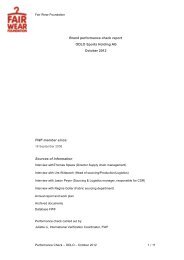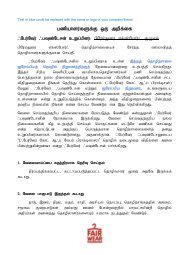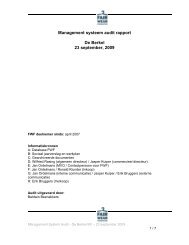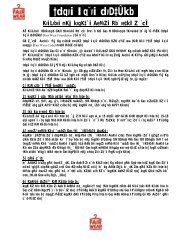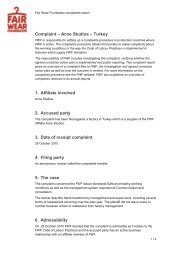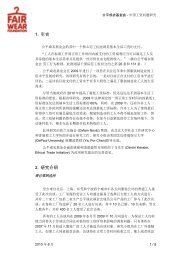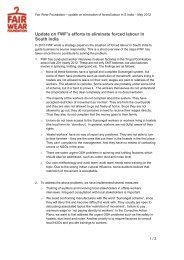Background Study Tirupur - Fair Wear Foundation
Background Study Tirupur - Fair Wear Foundation
Background Study Tirupur - Fair Wear Foundation
You also want an ePaper? Increase the reach of your titles
YUMPU automatically turns print PDFs into web optimized ePapers that Google loves.
2.7. Strengths and Weaknesses<br />
The <strong>Tirupur</strong> industry has certain strengths like the ability to take up small orders<br />
at short notice. The industry is also able to produce the entire range of knitwear<br />
at low cost and reasonably good quality.<br />
However, among the weaknesses of the industry are the occasional delays in delivery, the<br />
inability of many firms to match the quality standards demanded at higher price points and<br />
the inability of the industry at the lower end of the market to compete with the Chinese and<br />
exports form Bangladesh and Sri Lanka.<br />
It is perceived that among the major threats faced by the industry are the phase out of quotas,<br />
non-tariff barriers on account of the environment and social issues like child labour and<br />
personal safety norms and the inability to reap benefits of economies of scale due to fragmented<br />
holding of the manufacturing capacity. (IICI:37)<br />
Thus <strong>Tirupur</strong> can be said to specialise in relatively low volumes, fashion sensitive products<br />
but not of high value garments for niche markets. This is in line with India’s overall export<br />
profile, concentrated on the cotton, semi-fashion middle price segment. (ILO/Joshi 44) The<br />
minimum scale for efficient production in India is much lower than for example in China or<br />
Bangladesh. The degree of subcontracting is much higher (ILO/Joshi 46). The industry is<br />
highly dependent on agents and buying companies.<br />
The state government and local municipal authorities have been too slow to cope with this<br />
dynamic growth. The variance between the town’s infrastructure and the actual requirements<br />
has led to a sharp rise in the cost of almost every basic social input. The present exportdriven<br />
prosperity is letting <strong>Tirupur</strong>’s entrepreneurs meet these costs, but the paucity of adequate<br />
infrastructure could soon thwart its growth.<br />
Water scarcity is the biggest problem in <strong>Tirupur</strong>. This is further aggravated by a 50% growth<br />
in population in the past ten years, presently pegged at 500,000. Another problem identified<br />
is the issue of industrial pollution. (IICCI)<br />
Overall costs of living are high, according to some higher then for example in Bangalore.<br />
Another weakness is the lack of ‘permanent’ skilled workers. (Krishnamoorthy 55)<br />
The low level of overall productivity can also become a major hindrance. According to the<br />
Global Competitiveness Report 1999, wage adjusted for productivity in India is very high,<br />
much higher than in China for example. Specific for the <strong>Tirupur</strong> garments industry is the<br />
problem of low productivity due to slack periods between seasons that also leads to low utilisation<br />
levels of imported machinery. This is caused by the fact that industry in <strong>Tirupur</strong> has<br />
concentrated mainly on the production of garments for the spring and summer seasons. <strong>Tirupur</strong><br />
companies are looking to diversify its production range to include winter garments, but<br />
they are faced with the problem that <strong>Tirupur</strong> has no image for winter merchandising, like<br />
China and Vietnam. Hence <strong>Tirupur</strong> producers did not succeed in gaining a market share in<br />
fleeces.<br />
One of the larger <strong>Tirupur</strong> companies is Astro Apparel's. Its chairman mr. Venkatasubramanian<br />
‘believes the real issue is labour productivity. Without adding a single new piece of machinery,<br />
he believes it would be possible to grow his turnover from the current Rs 9 crore to<br />
Rs 15 crore in a year.<br />
In October last, Venkat was part of a 32-member team that visited the Guangzhou province<br />
in China. He found that both the costs of labour and raw material were almost the same as<br />
back home. The crucial difference was productivity. According to Venkat, the Chinese worker<br />
had a 200-250% higher productivity using the same machinery.<br />
Back in <strong>Tirupur</strong>, Venkat began to secretly monitor his workers' productivity levels. But once<br />
the workers got to know, they stopped working. They weren't keen on their wages being<br />
11



